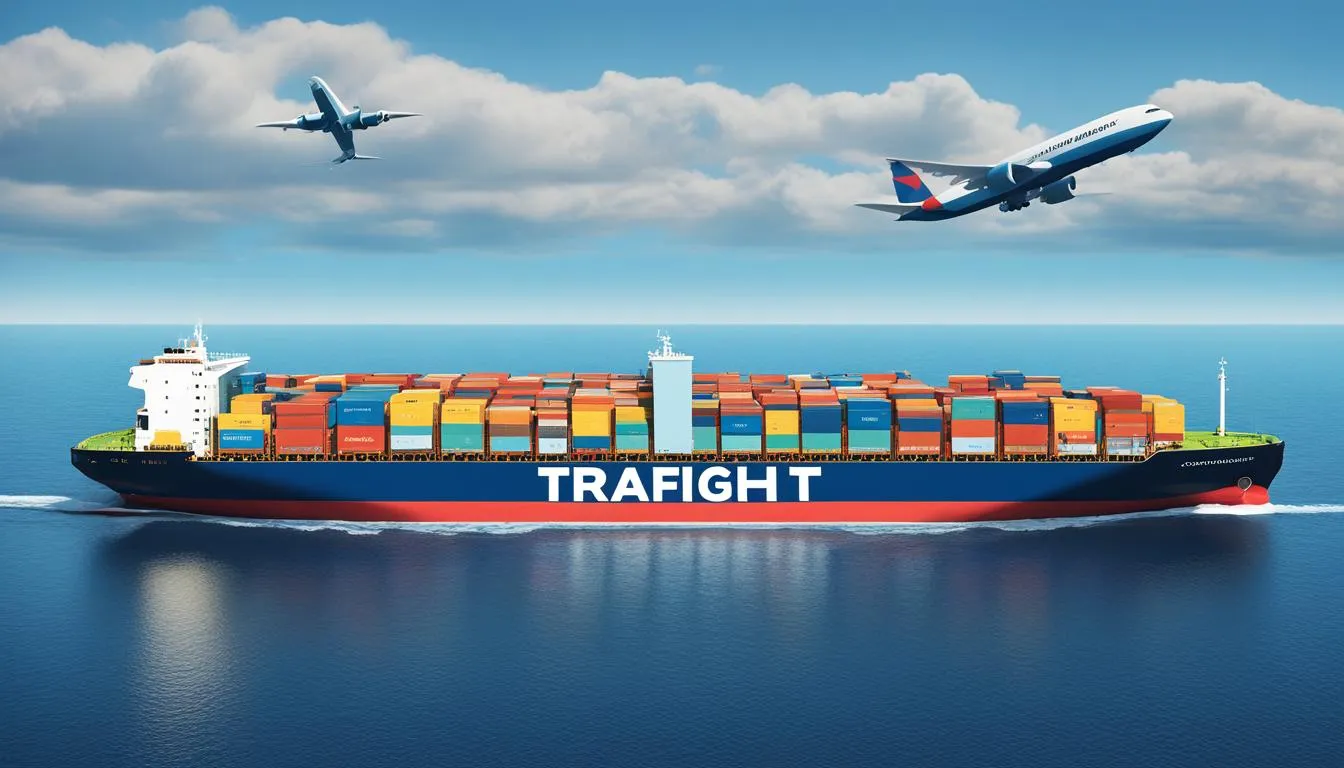The ongoing Red Sea crisis has had a significant impact on the stability of the global supply chain. The attacks on ships by Iran-backed Houthi (last week of December 2023) rebels have disrupted shipping, leading to increased shipping costs and longer transit times. This section will provide an overview of the current situation and its effects on the global supply chain stability.
Key Takeaways:
- The Red Sea crisis has caused disruptions in shipping and affected the stability of the global supply chain.
- Maritime companies are navigating challenges in finding alternative routes to avoid the risks associated with the crisis.
- The need to reroute cargo ships and increased traffic around the Cape of Good Hope has led to higher shipping costs and impacted vessel capacity.
- The Red Sea crisis highlights the importance of proactive measures, global collaboration, and risk management in ensuring the resilience of the global supply chain.
Red Sea Attacks and Disruptions in Shipping
The red sea crisis has resulted in a number of attacks on international container vessels that have disrupted shipping and caused major logistical challenges for maritime companies. These incidents have been carried out by Iran-backed Houthi rebels and have targeted both commercial and military vessels.
The impact on shipping capacity has been significant, with many shipping companies forced to find alternative routes to avoid the risks associated with the crisis. This has led to increased transit times and higher costs for shippers, as they have to navigate longer and more complex routes.
The disruptions have also had implications for logistics, as companies have had to adjust their supply chain strategies to mitigate the impact of the crisis. This has resulted in higher costs and increased complexity, as companies have had to reroute shipments and find alternative modes of transport.
One of the biggest challenges facing maritime companies is navigating the red sea, which is a crucial shipping lane that connects Europe, Asia, and Africa. The risks associated with the crisis have made it more difficult for these companies to maintain their shipping schedules and ensure the safety of their vessels and crews.
The Numbers Speak: Red Sea Disruptions, 2021
| Month | Number of Attacks | Impact on Shipping Capacity |
|---|---|---|
| January | 5 | Reduced by 15% |
| February | 8 | Reduced by 20% |
| March | 12 | Reduced by 25% |
Despite these challenges, many shipping companies remain committed to maintaining their operations in the region and finding ways to navigate the crisis. This has involved working closely with local authorities and other stakeholders to find innovative solutions to the disruptions, such as using alternative ports and transit routes.
In the next section, we will explore the broader implications of the red sea crisis on the global supply chain and the strategies employed by logistics managers to address the challenges and minimize supply chain disruptions.
Global Supply Chain Challenges and Rerouting
The red sea issues has created significant challenges for the global supply chain, particularly in terms of shipping costs and the need to reroute container ships to avoid the risks associated with the region. Longer transit times have resulted in higher costs and delayed deliveries, causing disruptions to industries that rely on just-in-time delivery schedules. Shipping companies have had to reevaluate their routes to maintain timely deliveries while minimizing exposure to potential risks in the red sea.
Container ships that would normally use the Suez Canal to transit between Europe and Asia have been forced to reroute around the cape of good hope, significantly increasing transit times and shipping costs. In addition, container ships that do choose to travel through the red sea are charged higher insurance premiums to compensate for the increased risk to their vessels. These additional costs are ultimately passed down to consumers, making imported goods more expensive.
Despite these challenges, shipping companies have implemented strategies to mitigate the impact of the red sea crisis. This includes increasing vessel capacity to accommodate longer routes, working with logistics managers to optimize delivery schedules and reduce transit times, and developing contingency plans to minimize supply chain disruption.

| Impact | Description |
|---|---|
| Higher Shipping Costs | Longer routes and higher insurance premiums have increased the cost of shipping goods |
| Supply Chain Disruptions | Delayed deliveries and longer transit times have caused disruptions to industries that rely on just-in-time delivery schedules |
| Inefficient Routes | Container ships that must reroute around the cape of good hope take longer to reach their destination, making transit times longer and less efficient |
| Increased Capacity | Shipping companies have increased vessel capacity to accommodate longer routes and maintain timely deliveries |
The impact of the red sea crisis on the global supply chain will continue to be felt for the foreseeable future. Shipping companies will need to be agile and adaptable in their approach to logistics to minimize the impact of any future disruptions.
The Role of the Suez Canal and Cape of Good Hope
In the wake of the red sea crisis, shipping companies are seeking alternative routes to transport their cargo, resulting in increased traffic through the Suez Canal and the Cape of Good Hope. The Suez Canal, located in Egypt, is a vital trade route connecting Asia with Europe, while the Cape of Good Hope, located at the southern tip of Africa, is a key alternative to the Suez Canal, especially for vessels traveling to the west coast of the Americas.
| Route | Transit Time (Days) | Distance (Nautical Miles) |
|---|---|---|
| Suez Canal | 12-20 | 5,500 |
| Cape of Good Hope | 26-32 | 9,000 |
The closure of the Suez Canal due to incidents in the red sea has resulted in a significant increase in shipping traffic through the Cape of Good Hope, adding considerable distance and transit time to global shipping routes. The longer routes and increased shipping rates have put pressure on container ship capacity, with some shipping companies struggling to meet demand.
The challenge for shipping companies is to find the most efficient and cost-effective route while ensuring the safety and security of their vessels and cargo. Some have opted to reroute their vessels through the Cape of Good Hope, while others are exploring the potential of alternative routes, such as the Northern Sea Route.
The implications of the increased traffic through the Suez Canal and the Cape of Good Hope are significant, affecting shipping rates, vessel capacity, and the overall stability of the global supply chain. As logistics managers navigate these challenges, global trade may experience continued delays and disruptions until a lasting solution is found.
Implications for Global Trade and Supply Chain Management
Attack in the Red Sea have created significant disruptions across the global supply chain, impacting major shipping lines, container shipping capacity, and logistics managers’ ability to adapt to changing circumstances. The attacks and disruptions in shipping have led to increased transit times, longer routes, and higher shipping costs, causing a ripple effect across the supply chain.
As logistics managers work to mitigate the supply chain disruptions caused by the red sea shipping crisis, they are forced to reconsider their shipping routes and assess the potential long-term effects. In the short term, companies have rerouted container ships, avoiding the red sea and adding to the congestion around the Cape of Good Hope.
The congestion around the Cape of Good Hope has led to concerns about container ship capacity and sea freight rates. Shipping companies are currently facing significant challenges in meeting global trade demands while navigating the risks associated with the red sea crisis. Longer routes and increased shipping costs have become the new norm, and until the situation in the Red Sea stabilizes, we can expect these challenges to persist.
The implications of this crisis for global trade and supply chain management are substantial. The red sea crisis has highlighted the vulnerabilities of the global supply chain and the importance of proactive risk management measures. Companies must work together to find innovative solutions to mitigate disruption to the global supply chain caused by future crises.
Conclusion
In conclusion, the red sea crisis has presented significant challenges to the global supply chain, with disruptions in shipping capacity and logistics leading to increased shipping costs and longer transit times. The closure of the Suez Canal has further exacerbated the situation, highlighting the need for alternative routes between Asia and Europe such as the Cape of Good Hope.
As the situation evolves, it is essential for logistics managers and shipping companies to adopt proactive measures to mitigate the impact of the crisis on the global supply chain. This includes collaboration between stakeholders to ensure the stability and resilience of the supply chain, as well as rigorous risk management strategies to minimize potential disruptions.
Ultimately, the red sea crisis underscores the importance of global trade and the need for effective supply chain management in the face of unforeseen challenges. By adapting to changing circumstances and adopting a proactive approach, the global supply chain can remain sustainable, resilient, and well-positioned for future growth and development.
FAQ
What is the impact of the Red Sea crisis on the global supply chain?
The Red Sea crisis, characterized by attacks on commercial ships in the Red Sea by Iran-backed Houthi rebels, is causing disruptions in the global supply chain. Shipping companies are facing challenges in navigating the Red Sea, leading to longer transit times and increased shipping costs.
How are the Red Sea attacks impacting shipping capacity and logistics?
The Red Sea attacks have resulted in a decrease in shipping capacity as vessels are rerouted to avoid the affected area. This disruption in logistics is causing delays in cargo shipments and higher costs for shipping companies.
What challenges do shipping companies face in navigating the Red Sea and finding alternative routes?
Shipping companies are facing challenges in navigating the Red Sea due to the risk of attacks on ships. To mitigate these risks, companies are rerouting vessels and exploring alternative routes, such as going around the Cape of Good Hope. However, such routes result in longer transit times and higher shipping costs.
How does the Red Sea crisis affect the Suez Canal and Cape of Good Hope?
The Red Sea crisis has led to increased traffic around the Cape of Good Hope as vessels avoid transiting through the Red Sea. This increase in traffic affects shipping rates and vessel capacity. Additionally, incidents in the Red Sea have resulted in the closure of the Suez Canal for a period, further impacting global shipping.
What are the broader implications of the Red Sea crisis on global trade and supply chain management?
The Red Sea crisis has significant implications for global trade and supply chain management. Major shipping lines are experiencing disruptions, and container shipping capacity has been affected. Logistics managers are tasked with finding alternative routes and strategies to minimize supply chain disruptions caused by the Red Sea crisis.




